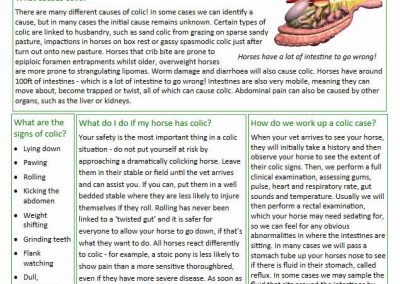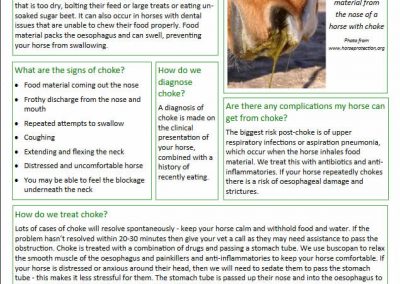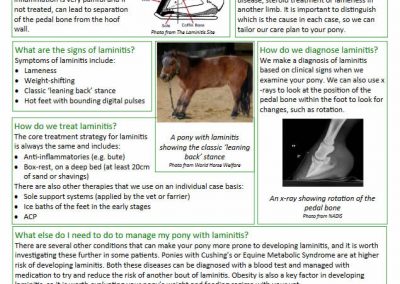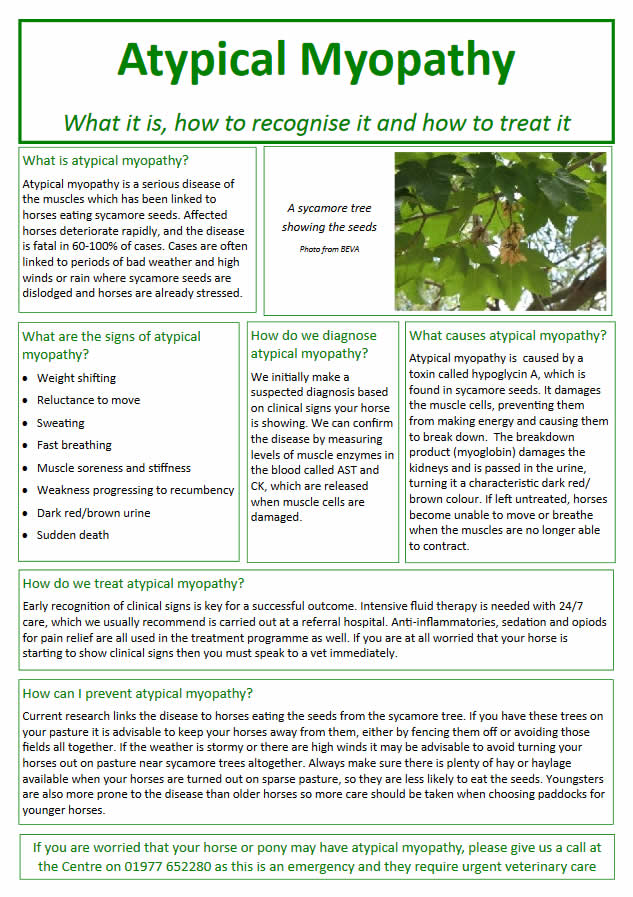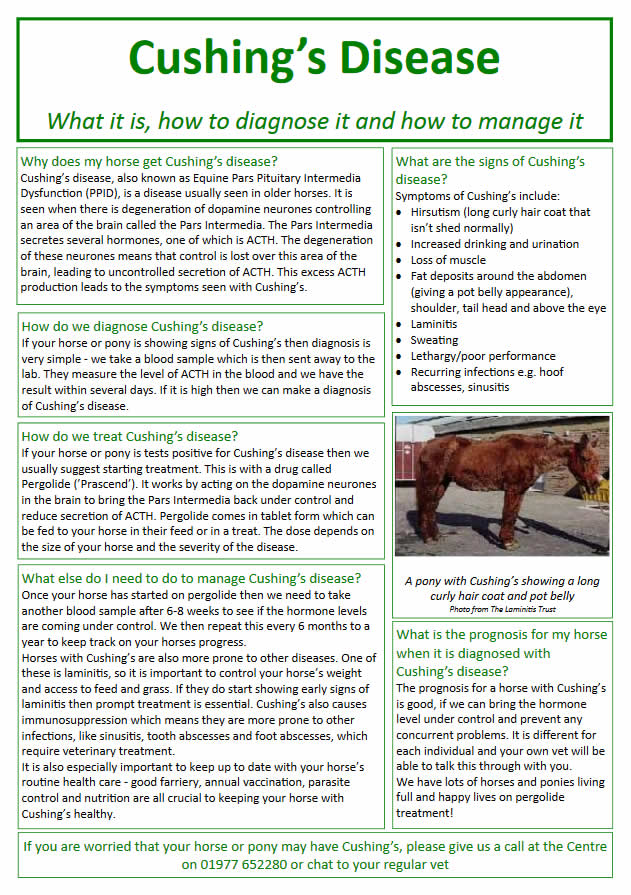Our Information Sheets
All health articles have been written by Horse Vets, The Equine Veterinary Centre and are for informational purposes only
Behaviour and Cycling Mares
 Mares are ‘long day breeders’ meaning that they usually breed during late spring, summer and early autumn. Mares are also termed seasonally polyoestrous breeders, that means they cycle (have oestrous cycles) many (poly) times per year but only during the breeding season (seasonally).
Mares are ‘long day breeders’ meaning that they usually breed during late spring, summer and early autumn. Mares are also termed seasonally polyoestrous breeders, that means they cycle (have oestrous cycles) many (poly) times per year but only during the breeding season (seasonally).
A mare’s cycle (oestrous cycle) lasts between 21-23 days. During this time she will have 3-8 days of standing heat where she would be receptive to a stallion for breeding. A mare’s behaviour will change during her cycle. During the non-breeding or anoestrus period (winter) a mare will not show signs of “heat” or breeding as her reproductive system become less active. Each mare will show different behaviour during her cycle and so it is important that you become aware of your horse’s tendencies.
What are the signs of standing heat?
The signs of heat can differ from mare to mare and can be difficult to detect to the untrained eye. Teaser animals are often used to determine whether a mare is in season or not. Mares in season usually display one or more of the following signs: When approached they may squeal and attempt to kick Mares will often dribble small quantities of urine whilst holding their tails high One of the more obvious signs is of “clitoral winking” with the lips of their vulva
As the mare reaches the peak of the heat display period, she will often “show” continuously and almost demand attention from stallions. The mare may ovulate at some stage throughout the period of standing heat but this can be quite variable. Once the mare has ovulated she will cease to display the signs of oestrous and will in fact become quite aggressive.
Care must be taken at this point to avoid injury to the teaser or stallion. This stage is called “dioestrous” which lasts for 10 to 16 days upon which the mare will again commence her cycle. One of our vets will be able to provide further advice on breeding and cycling mares.
Pre-Purchase Veterinary Examination
Pre-purchase examinations are often not a significant portion of the final selling price of a horse and investing in a ‘vetting’ may save you money, time and effort in the long run. You must discuss with the veterinary surgeon that will be doing the examination what type of work you hope the horse will do.
If the horse passes the examination then a certificate will be issued by the veterinary surgeon. This certificate can be used for insuring the horse or pony when the sale is completed.
The five stage vetting
This is carried out in accordance with guidelines laid down by the Royal College of Veterinary Surgeons (RCVS) and the British Equine Veterinary Association (BEVA) is the recommended form of exam. At the time of the vetting always ask for a blood test to be taken to check for the presence of pain killing drugs.
If the horse subsequently becomes lame the blood can be tested to see if there was any drug present at the time of the vetting.
This insurance policy protects buyers, sellers and veterinary surgeons. The 5 stage test may take a couple hours to complete and someone will need to be available to ride the horse.
Stage 1 – observe the horse at rest in a darkened stable and check normal parameters, look at the eyes and listen to the heart. Your vet will check for any stable vices, however you should discuss this with the seller since, in the short time that it takes to do the test, the vet cannot warrant that the horse is free of them.
The horse will then be taken outside, in good light, and be examined for lumps, bumps, blemishes and old injuries. The teeth may be checked to determine the age. Body condition and conformation will be noted.
Stage 2 – walking and trotting in hand on a hard surface. Looking for signs of lameness and your vet may choose to carry out flexion tests. Lunging on both reins in a tight circle will exaggerate any subtle lameness.
Stage 3 – ridden under saddle, checking for reaction to being mounted, ridden and requires more strenuous exercise. The vet will listen for abnormal ‘wind’ noises during work and heart abnormalities afterwards.
Stage 4 – cooling off period and check for signs of stiffness after exercise.
Stage 5 – looking with greater depth in areas that were of concern in previous stages. A blood sample will be collected and stored. The vet will ask for a final trot up.
On completion the vet must then give their opinion, as observed on that day, to the prospective buyer as to whether, on the balance of probabilities, the horse will be suitable for the type of work that the buyer requires the horse for.
Vettings are areas where lawsuits have arisen and therefore vets carry them out thoroughly, carefully and any findings are fully documented.
The vendor’s certificate
The second type of pre-purchase examination is called a vendor’s certificate. This is sometimes issued by the vendor (seller) or by the vendor’s veterinary surgeon prior to selling the horse.
These are not to be confused with a 5 stage veterinary examination and if in doubt then contact us for further advice.
Euthanasia
The staff at the Equine Veterinary Centre are more than happy to discuss your horse’s condition and possible options at all times.
Euthanasia can be carried out by injection given by a vet or shooting by a registered slaughterman.
Why should I choose injection?
If you wish to be with your horse when he or she is put to sleep you may find this method less traumatic. The horse is given an overdose of an anesthetising agent.
Why should I choose shooting?
Shooting is extremely quick and perfectly humane providing it is done by a competent person. It usually involves less expense as the body may be used for animal consumption. Nervous horses can be sedated by a vet prior to shooting.
What will happen to my horse afterwards?
Whichever method of euthanasia is chosen, most horses will be taken for cremation. Individual cremation with the option of the ashes being returned or group cremation without ashes being returned. Burial is possible in certain circumstances. We can make all the arrangements for our clients horses to be taken for cremation if required.
Am I allowed to bury my horse?
Legislation prevents the burial of food animals (which includes horses according to European definitions). If you can prove that your horse or pony has been kept as a pet, burial may be permitted.
In this situation, you should seek local authority approval and adhere to other regulations governing the depth of the hole and distance away form watercourses and drains (Refer to DEFRA website)
When to call your vet
Minimum requirements on when to call a veterinary surgeon
According to the Equine Industry Welfare Guidelines for Horses, Ponies and Donkeys (2nd Edition 2005) a veterinary surgeon should be consulted urgently by the owner or person in charge of the horse is there are any signs of:
- Acute abdominal pain or colic
- Serious injury involving deep wounds, severe, haemorrhage, suspected bone fractures or damage to the eyes
- Evidence of straining for more than 30 minutes by a mare due to foal
- Inability to rise or stand
- Inability or abnormal reluctance to move
- Severe diarrhoea
- Prolonged/ abnormal sweating, high temperature, anxiety, restlessness or loss of appetite
- Any other signs of acute pain or injury
- Respiratory distress
A veterinary surgeon should be consulted within 48 hours of the owner or person in charge becoming aware of the following conditions:
- Marked lameness that has not responded to normal first aid treatment
- Injury that has not responded to normal first aid treatment
- Signs suspicious of Strangles or other infectious disease, nasal discharge, raised temperature, enlarged lymph nodes or cough
- Sustained loss of appetite
- Persistent weight loss
- Skin conditions that have not responded to treatment, including saddle sores and girth galls
- Other sub-acute illness or injury
Of course there are many other reasons why you will want to call your vet for assistance and you should feel free to do so. This list is a minimum indication of the attention that should be available to animals in distress.
Normal Parameters
Heart rate:
At rest = 28-48 beats per minute
At exercise = up to 200 beats per minute
The heart rate is measured with a stethoscope or by feeling the pulse in the lower leg or jaw and a stopwatch. If at rest the heart or pulse rate is raised this may be a sign that the horse is in pain or stressed.
Breathing (respiratory) rate
At rest = 10-14 breaths minute
Breathing rate can be measured with a stethoscope or watching the sideways expansion of the chest.
The rate can often be raised when the horse is stressed or sick.
Body (rectal) temperature
Normal Temperature = 99.5-101.3°F or 37.5-38.5° C
The temperature is taken by inserting the thermometer into the anus of the horse and holding against the side of the rectum. Low readings may be taken if the thermometer is inserted into a piece of faeces by accident. It is important to seek advice from your veterinary surgeon if you are inexperienced at this.
Routine Checks
It is advisable that your veterinary surgeon performs an annual health check on your horse. However you, as the owner, can perform regular checks and ensure that any signs of disease are identified early. In most cases routine checks on your horse are second nature and often you will perform them subconsciously every time you tend your horse. However the following is a useful check list (although by no means exhaustive) to make on a regular basis:
- Skin and coat
- Teeth and eating
- Eyes, ears, nose
- Legs
- Urine and faeces
- Sheath, vagina
- Appetite and water intake
- Behaviour
If anything appears out of the ordinary then contact you veterinary surgeon who will be able to give you advice.
Stomach Ulcers
Possible signs include…
• Poor Performance
• Dull Appearance
• Picky Appetite
• Grumpy Temperament
• Resistance to Riding Aids
• Resistance to Girthing
• Colic
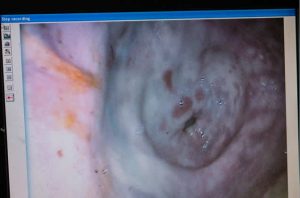 Signs
Signs
of gastric ulceration can be vague and many horses will display few signs. Gastroscopy involves passinga camera through the nose and into the stomach and is the only way to reliably diagnose ulceration.
Unlike humans who produce gastric acid as required, horses produce gastric acid constantly, whether they are eating or not. Saliva and roughage will help to protect against this acid, so periods without eating will increase the risk of high acid and gastric ulceration.
The horse’s stomach is divided into a glandular and a squamous area.
Causes and treatment of ulcers in these different areas differs.
Squamous ulceration is caused by splashing of stomach acid into this region at the top of the stomach. This most often occurs during exercise and feeding of 1 – 2l of chaff prior to exercise can help form a protective mat and prevent recurrence.
Glandular ulceration is caused when there is a breakdown in the stomach’s normal protective layer. This can be harder to treat and manage. Treatment to help line and protect the stomach will be recommended.
Minimising stress and maximising roughage in the diet are both important. More food should be given during the day and less at night if your horse requires restricted feeding and ad-lib roughage is not appropriate.
For further advice and discussion please do not hesitate to contact us. If you would like to book in for gastroscopy then your horse will need to be starved overnight prior to the procedure in order for us to see all areas of the stomach.
This means no straw bedding or turnout, but your horse is welcome to stay overnight at our clinic the night before free of charge in order to fast fully. Your horse will have standing sedation for the procedure and can go home the same day. You may be worried purely about if your horse has ulcers or not, for example if your horse doesn’t like girthing but seems otherwise fit and well. Alternatively you may have more concerns over your horse’s health, of which ulcers are a possibility.
Gastroscopy will be performed by our veterinary surgeon with a certificate in Advanced Veterinary Practice (Equine Medicine), who will discuss any further points of concern.
Atypical Myopathy
Cushing's Disease
Laminitis
Choke
Colic
Find Us
Equine Veterinary Centre
Moorhouse Equestrian Centre
Gap Farm
Moorhouse Lane
Doncaster
South Yorkshire
DN6 7HA
Telephone 01977 652280
Emergencies
We are small enough to offer you a personal and professional approach but big enough to provide a high level of service and 24 hour emergency cover to our registered clients.
Opening Hours
Monday – Friday: 9:00 am – 5:30 pm
Saturday: 9:00 am – 12:00 pm
We are based in the countryside just off the Wakefield (A638) Road at Moorhouse Equestrian Centre and there is plenty of parking.
Would not have any other vets, all staff are friendly, caring and helpful, all vets are great at their job and also care about the horses.
Excellent service, highly recommended.
Fantastic veterinary practice – have looked after my medically challenged neddies for the last ten years, and have always gone above and beyond for all 3 of them.
Can’t thank the whole team enough – there’s always a friendly voice on the end of the phone when you’re panicking, and all of the vets are exceptional.
Would recommend to anyone who will listen!
Very helpful and friendly team.
I’ve seen most of the vets at this practice over the years and have always received exceptional care for my horses.
Thank you!
